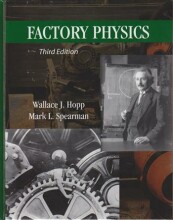Basic Factory Dynamics - Definitions and Parameters
10 important questions on Basic Factory Dynamics - Definitions and Parameters
Figure 7.1 is not coherent with the text on page 232. Can you spot the mistake?
The text says "y percent of parts processed at station 1 are scrapped before reaching station 2" whilst in the figure 1-y are scrapped and y are fed through to station 2.
Since the arrival rate in the equation for the 2nd station's utilization is defined as yr, this implies that y is the fraction of products reaching station 2. If this is considered to be true, then the text is false and figure 7.1 is correct.
Consider an unbalanced line with 3 stations in tandem.
Station 1 has two machines, process time per machine is 1,5 hours.
Station 2 has five machines, process time per machine is 4 hours.
Station 3 has three machines, process time per machine is 2 hours.
What is the bottleneck rate (Rb)? What is T0? What is W0?
Station capacity=#machines / process time per machine -> Rb = 1,25 jobs per hour (station 1)
To = 1,5 + 4 + 2 = 7,5 hours
Wo = Rb x To = 1,25 x 7,5 = 9,375 products.
A line has 4 multi-machine stations in tandem, station 2 & 4 contain three & four machines, respectively. Station 1 contains double the amount of machines of that of station 3. W0 = 10 and the line is balanced.
How many machines does station 1 have? How many does station 3 have?
In a balanced line the number of machines equals W0, so there are 10 machines total.
Station 2 & 4 account for 7 of them. This means station 1 & 3 have 3 machines left among them. Station 1 contains double that of station 3, so station 1 has 2 machines and station 3 has 1 machine.
- Higher grades + faster learning
- Never study anything twice
- 100% sure, 100% understanding
A line is balanced and W0 = 12, yet there are 11 machines, is this possible?
It is only possible when 1 machine can process 2 products at the same time.
What happens when the arrival rate of a machine exceeds the effective production rate? Does this mean utilization can go greater than 100%?
A queue of work is then building up (as is WIP).
Using the definition of utilization = arrival rate / effective production rate, utilization can theoretically go over 100%.
When utilization is defined as the fraction of time it is not idle for lack of parts, then utilization cannot go over 100%.
In practice, you can not use a machine 25 hours a day, so in that sense utilization is maxed out at 100%.
Is it possible to have more than one bottleneck station in the same multi-machine line?
Yes, when both stations have an equally low capacity, lowest compared to other stations.
At the firm level, throughput is defined as the production per unit time. How do managers of production lines define throughput?
The average quantity of good (nondefective) parts produced per unit time
An upper limit on the troughput of a production process is its capacity. What will be the consequence (in most cases) of releasing work into the system at or above the capacity?
The system becomes unstable (i.e., build up WIP without bound).
Define the bottleneck rate (Rb) of a line.
The bottleneck rate of the line is the rate (parts per unit time or jobs per unit time) of the workstation having the highest long-term utilization
Consider Penny Fab Two. In this case we have an unbalanced line with multimachine stations.
Station 1:
Number of machines: 4
Process Time (hours): 8
Station 2:
Number of machines: 1
Process Time (hours): 5
Station 3:
Number of machines: 3
Process Time (hours): 6
Station 4:
Number of machines: 2
Process Time (hours): 6
Determine the critical WIP level.
We know that the critical WIP level (W0) is defined as: W0 = Rb x T0
Step one: determine T0.
T0 = 8 + 5 + 6 + 6 = 25 hours
Step two: determine Rb.
Capacity station 1: (4/8) = 0,50 jobs/ hour
Capacity station 2: (1/5) = 0,20 jobs/ hour
Capacity station 3: (3/6) = 0,50 jobs/ hour
Capacity station 4: (2/6) = 0,33 jobs/ hour
The bottleneck rate Rb in this line is 0,2 penny per hour.
Step three: determine W0.
W0 = Rb x T0 = 0,2 x 25 = 5 pennies
The question on the page originate from the summary of the following study material:
- A unique study and practice tool
- Never study anything twice again
- Get the grades you hope for
- 100% sure, 100% understanding
































